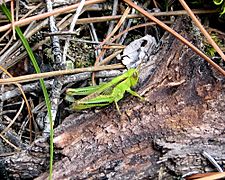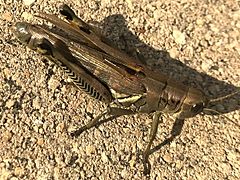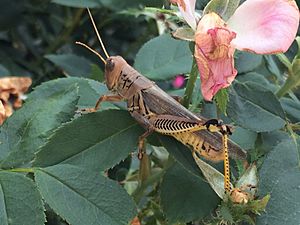Differential grasshopper facts for kids
Quick facts for kids Differential grasshopper |
|
|---|---|
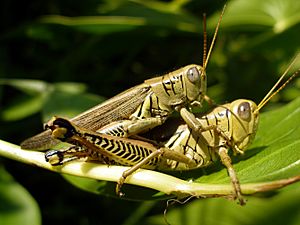 |
|
| Differential grasshoppers | |
| Scientific classification | |
| Genus: |
Melanoplus
|
| Species: |
differentialis
|
| Subspecies | |
|
|
The differential grasshopper (Melanoplus differentialis) is a common type of grasshopper. It belongs to a group of grasshoppers called Melanoplus. You can find these insects in northern Mexico, the central United States, and southern Ontario, Canada. Sometimes, they can cause problems for farmers.
Contents
What Do Differential Grasshoppers Look Like?
Adult male differential grasshoppers grow to be about 28–37 millimeters long. Females are a bit larger, reaching 34–50 millimeters. They are usually brownish or greenish. As they get older, their color often becomes darker. Young grasshoppers, called nymphs, can sometimes be bright yellow.
These grasshoppers have special black grooves on their back, near the head. Male grasshoppers have unique boot-shaped parts at the end of their body. Their back legs have upside-down V-shapes. The lower part of their back legs is yellowish with black spikes. All adult differential grasshoppers have yellow feet and antennae. Sometimes, their antennae are reddish-yellow.
-
A female grasshopper ready to lay eggs in Naperville, USA.
Where Do Differential Grasshoppers Live?
You can find differential grasshoppers in most parts of the United States, except for the northwest. They prefer to live in areas with lots of weeds and in grasslands. You might even spot them in empty lots or other city areas.
These grasshoppers do not migrate long distances. However, they can travel a few miles to find food. In colder northern areas, they are as common as the two-striped grasshopper. But in warmer southern areas, the differential grasshopper is much more common.
The Life Cycle of a Differential Grasshopper
Differential grasshoppers usually have one generation each year. A female grasshopper can lay up to six groups of eggs in soft soil. Each group can hold between 40 and 200 eggs!
The eggs start to develop in the summer they are laid. Then, they go into a resting state for the winter. This resting state is called diapause. The eggs hatch over about two weeks in the early summer of the next year. After hatching, the young grasshoppers, or nymphs, take about 32 days to become adults. Most nymphs turn into winged adults around the same time, usually within a few days.
Differential grasshoppers eat many different kinds of plants. They eat both grasses and broad-leaf plants, which are called forbs. Studies show they grow faster when they eat forbs. Their favorite foods include giant ragweed, common sunflower, and prickly lettuce. Adult grasshoppers can even tell if lettuce or sunflowers are wilting. They will usually avoid eating those plants.
Why Are They a Problem for Farmers?
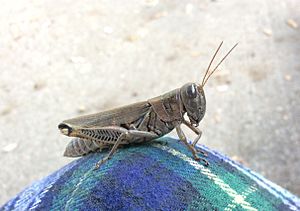
Young differential grasshoppers like to eat grains, alfalfa, and hay crops. Adult grasshoppers attack corn, cotton, and fruit trees. A large group of these grasshoppers can destroy a whole crop in just a few days.
Because these grasshoppers often feed in big groups, they can be a serious threat to farms. This is true in many areas where they live. Farmers often need to find ways to protect their crops from these hungry insects.


